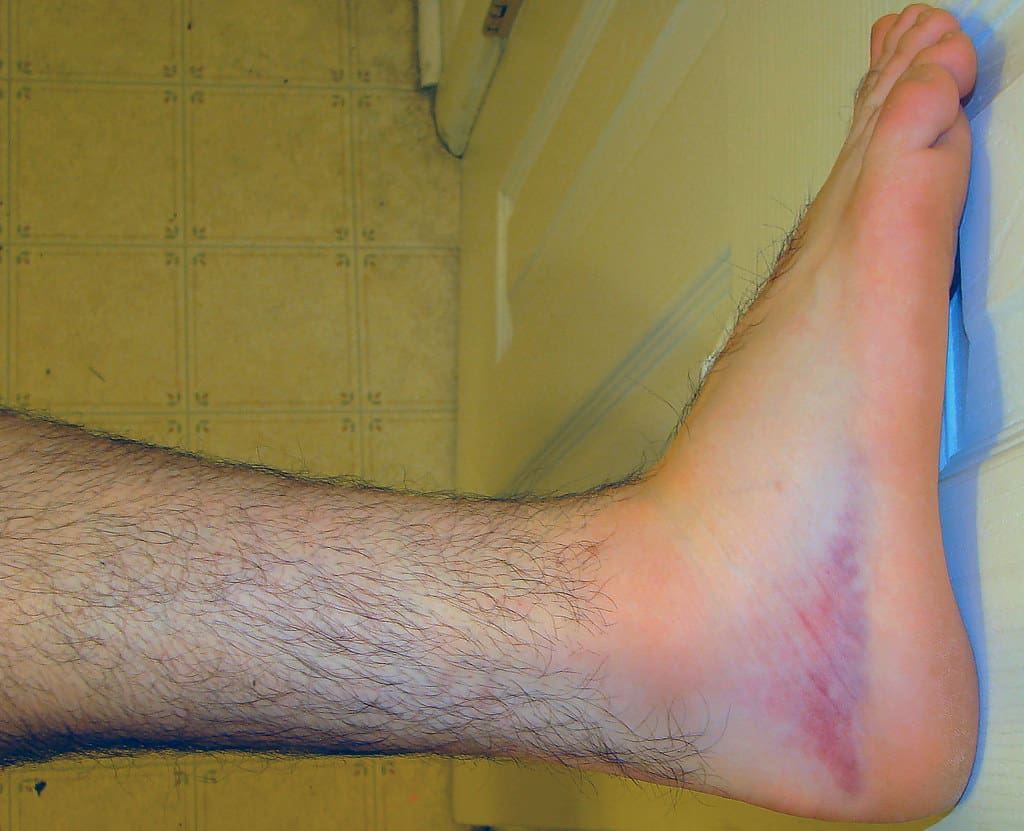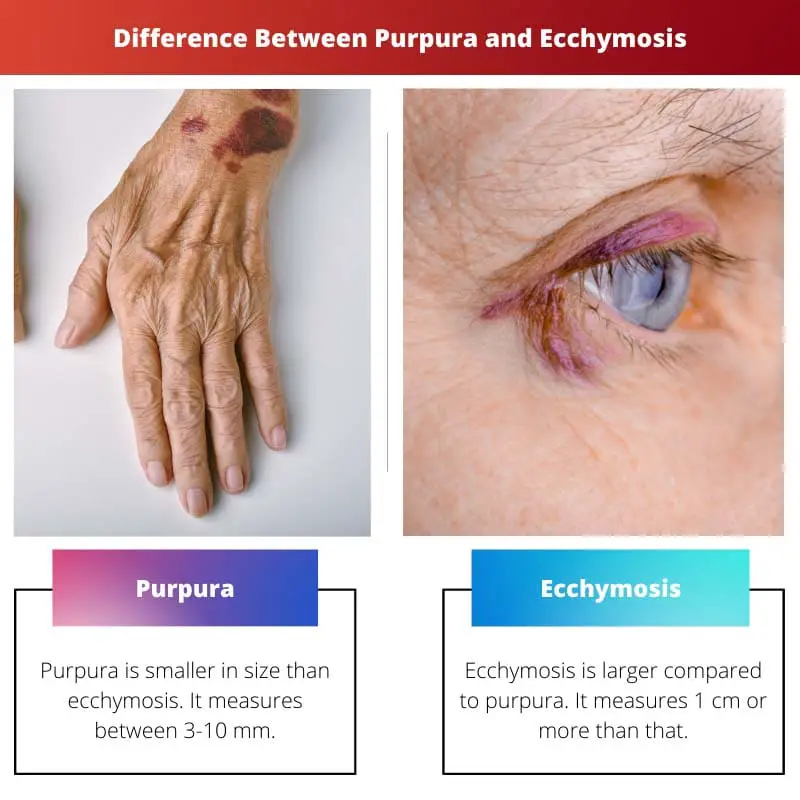Manifestations in the skin are one of the most significant signs that patients and health workers frequently overlook. These signs need medical attention. Not giving attention to these dermatological changes can put the lives of the patients in peril. Purpura and ecchymosis are dermatological manifestations that are closely related to vasculitis.
Key Takeaways
- Purpura is small, red or purple skin discolorations, while ecchymosis is a larger area of bruising.
- Purpura results from damaged blood vessels, whereas ecchymosis occurs due to leakage from ruptured vessels.
- Ecchymosis develops following trauma, while purpura has various causes, including infection and immune disorders.
Purpura vs Ecchymosis
Purpura is another name for skin hemorrhage or blood clot, and it is a medical condition that happens when the blood vessels in your body open, causing blood to pile under the skin. Echhymosis is a condition that occurs when blood pours from a blood vessel and piles in the tissue under the skin.

Purpura is a purple-reddish skin haemorrhage measured between 3-10 mm. The spots sometimes appear on mucous membranes, especially on the membranes on the mouth or any other organs. It occurs when blood vessels burst, which causes blood to gather under the skin. It causes a reddish purple spot on the skin, ranging from large patches to small dots.
Ecchymosis is the bluish or reddish discolouration on the skin that occurs due to an injury and measures one cm or more than one cm. It happens when blood leaks from the blood vessels and makes a blood pool into the nearby tissue under the skin. The area of ecchymosis changes from bluish or reddish to green or yellow as the tissue heals. It takes 1 to 3 weeks to heal.
Comparison Table
| Parameters of Comparison | Purpura | Ecchymosis |
|---|---|---|
| Size | Purpura is smaller in size than ecchymosis. It measures between 3-10 mm. | Ecchymosis is larger compared to purpura. It measures 1 cm or more than that. |
| Color | The purpura is a purple reddish skin hemorrhage. | Ecchymosis is the bluish or reddish discoloration on the skin and the area of ecchymosis changes from bluish or reddish to green or yellow, as the tissue heals. |
| Shape | Purpura is rounded skin discoloration, sometimes the bruises are flat or irregular in shape. | The shapes of ecchymosis are oval, rounded, or irregular. It may have a subcutaneous flat nodule at the center. |
| Cause | Purpura can cause by a recent bone marrow transplant, hormone replacement, stem cell transplant, chemotherapy, estrogen therapy, and so on. | Ecchymosis is caused by an injury like a fall or blow, bump. Sometimes medications like antibiotics, blood thinners (warfarin, aspirin), corticosteroids, increase bleeding and make ecchymosis. |
| Treatment | Different types of purpura need different treatments, most of the purpura is healed by taking drugs. | Most of the time it heals without any treatment if it is caused by an injury. In other cases, doctors may perform x-ray tests and MRI scans to identify the cause. |
What is Purpura?
Purpura is identified by small purplish or reddish spots on the skin, 3-10 mm in diameter. It is also known as a blood clot or skin haemorrhage, which can indicate several medical conditions, from minor injuries to life-threatening health issues. It occurs when blood vessels burst, which causes blood to gather under the skin.
The spots sometimes appear on mucous membranes, especially on the membranes on the mouth or any other organs. It causes a reddish purple spot on the skin, ranging from large patches to small dots. The purpura is a purple-reddish skin haemorrhage. Purpura is rounded skin discolouration; sometimes, the bruises are flat or irregular.
Unlike any other rashes, purpura will not blanch or change its colour when some pressure is given to the spot. Purpura can appear on the skin anywhere on the body, including the membranes on the mouth. Purpura must not be avoided by patients and also health professionals as purpura can be a symptom of a life-threatening disease.
Purpura is more like a symptom of other health issues rather than a health condition. Purpura can cause by a recent bone marrow transplant, hormone replacement, stem cell transplant, chemotherapy, estrogen therapy, and so on. Different types of purpuras need different treatments, most of the purpura is healed by taking drugs.
What is Ecchymosis?
The medical term for the common bruise is ecchymosis. The bluish or reddish discolouration on the skin occurs due to an injury and measures one cm or more than one cm. It happens when blood leaks from the blood vessels and makes a blood pool into the nearby tissue under the skin.
Ecchymosis is the bluish or reddish discolouration on the skin, and the area of ecchymosis changes from bluish or reddish to green or yellow, as the tissue heals. The shapes of ecchymosis are oval, rounded, or irregular. It may have a subcutaneous flat nodule at the centre.
Ecchymosis is caused by an injury like a fall or blow, or bump. Sometimes medications like antibiotics, blood thinners (warfarin, aspirin), and corticosteroids increase bleeding and cause ecchymosis. Medical conditions like blood clotting disorders and cancer can cause ecchymosis. Lacking vitamin C and vitamin K can also cause ecchymosis. Kids tend to have ecchymosis during the sports season.
Most of the time, it heals without any treatment if an injury causes it. In other cases, doctors may perform x-ray tests and MRI scans to identify the causes. Doctors may prescribe a blood test if the ecchymosis is severe. The blood count and blood healing responses measured by the blood test can assist in diagnosing the cause of ecchymosis.

Main Differences Between Purpura and Ecchymosis
- Purpura is smaller in size than ecchymosis. It measures between 3-10 mm. On the other hand, ecchymosis is larger compared to purpura. It measures 1 cm or more than that.
- The purpura is a purple-reddish skin haemorrhage. Ecchymosis is the bluish or reddish discolouration on the skin, and the area of ecchymosis changes from bluish or reddish to green or yellow, as the tissue heals.
- Purpura is rounded skin discolouration; sometimes, the bruises are flat or irregular. The shapes of ecchymosis are oval, rounded, or irregular. It may have a subcutaneous flat nodule at the centre.
- Purpura can be caused by a recent bone marrow transplant, hormone replacement, stem cell transplant, chemotherapy, estrogen therapy, and so on. An injury like a fall or blow, or bump causes ecchymosis. Sometimes medications like antibiotics, blood thinners (warfarin, aspirin), and corticosteroids increase bleeding and cause ecchymosis.
- Different types of purpura need different treatments, most of the purpura is healed by taking drugs. On the contrary, it heals without any treatment if an injury causes it. In other cases, doctors may perform x-ray tests and MRI scans to identify the cause.

It is important for both patients and healthcare providers to distinguish purpura and ecchymosis as they indicate different underlying health issues that require appropriate attention and care.
Differentiating purpura and ecchymosis is crucial for accurate medical assessment and intervention, which ultimately influences patient well-being.
The detailed explanations regarding purpura and ecchymosis are fundamentally important for increasing awareness and medical literacy in the general population.
Understanding the specific characteristics of purpura and ecchymosis can lead to more accurate diagnosis and treatment in medical settings.
Purpuric and ecchymotic lesions are indeed important signs of serious medical conditions, and the distinctions between the two are crucial. It’s important for healthcare workers to be able to recognize them in order to provide effective treatment.
Absolutely, patients may not always recognize the importance of these skin signs, but healthcare providers should be well-versed in identifying and interpreting them.
I agree, recognizing these skin manifestations and understanding the differences between them can greatly impact patient care outcomes.
Purpura and ecchymosis are notable indications that necessitate thorough evaluation to identify potential underlying health conditions and provide appropriate management.
Understanding the characteristics and origins of purpura and ecchymosis contributes to the comprehensive understanding of vascular manifestations and can enhance clinical decision-making.
The comparison table provided is very informative, highlighting the key differences between purpura and ecchymosis, making it easier to understand these medical conditions.
I completely agree, the table is an effective way to illustrate the contrasting characteristics of purpura and ecchymosis, and it can aid in educational and clinical contexts.